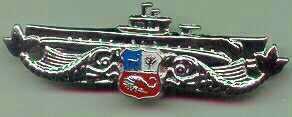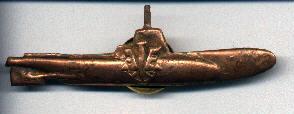|
PAKISTAN- The Pakistan Submarine Force has only been around for about thirty years when France sold Agosta Class submairnes to Pakistan. These were eventually supported by some Daphne Class submarines. Pakistan also uses midget submarines which can be used by their special operations personnel in the time of war. The Pakistan Submarine Fleet consist of nine submarines, 2 Hashmat Class, 4 Hangor Class, and 3 Cosmos midget submarines The current version of the submarine badge has a modern design sub with a double wreath appliqued around the center of the sub. The wreath is topped by a cresent and star. The gold version is for officers and the silver version is for enlisted personnel. It is worn on left breast pocket with the sub parallel to the pocket. The badge is long clutch pin attachment. |
|
PERU- Peru is one of the smallest South American countries to have submarines in its fleet. Their submarine fleet dates back to 1913 when they had two French-built Laubeuf boats. These subs were replaced by 4 Electric Boat submarines in 1926. These subs were in service until after World War II when they were replaced by 4 Abato Class submarines from 1954 t o1957. 2 Guppy Class followed. The current Peruvian Navy has eight submarines, 2 Abato Class and 6 Casma Class (German 209 Type 1200). The National Arms is appliqued on the submarine badge. Dexter chief quarter is in blue with a yellow llama. sinister chief quarter is white with a green cinchona tree, and the base is red with a yellow cornucopia. From 1929 to 1946, the Peruvian Submarine Badge was actually the U.S. Submarine Badge. Gold for officers and Silver for enlisted personnel. In 1949, Peru created its own design. The Peruvian Submarine Badge is a 1940 submarine. The National Arms is below the conning tower and is supported by two dolphins. Gold is for officers and silver is for enlisted and warrant officers. The badges are hollowed back and have a clutch pin attachment. Miniatures are about half as small. |


|
POLAND- Poland got her first submarines in 1926, three minelaying subs (Wilk Class). They were used until 1935. Netherland built two boats of the Orzel Class upon purchase from Poland. When Poland surendered to Germany, all five subs were out at sea. Three reamined in Netherland and two of them made it to England. The exiled Polish Navy received one US "S" Class and two British "U" Class which were all returned to England at the end of the war. Poland received three Whiskey Class from the Soviet Union in 1950 which were active for many years. The current submarine flett ahs one Whiskey Class and two Foxtrot Class submarines. The Polish badge was authorized in 1964. All of the badges have the Polish Eagle on the conning tower of the submarine. The gold version is for personnel qualified as Commanding Officers, the silver version is for officers, and the bronze version is for enlisted personnel. The badge is worn on the right side. The badge is screw post attachment. |


|
PORTUGAL- The exact starting of the Portuguese submarine force is not really known but the earliest boat that was commissioned was in 1912. At the end of World War I, the Portugese Submarine Fleet was three Laurenti-Fiat built submarines and an old class of submarine. This old submarine was eventually replaced by 3 submarines which were named after older submarines. These subs stayed in service well past World War II. England gave Portugal three "S" Class subs in 1948. At this time, the Portuguese Navy has three Albacora Class submarines which are modified Daphne Class submarines specifically designed for Porugal. The earliest version of the submarine badge dates back to 1915. In 1960 the bage was changed to a more modern design. The National Arms was added above the periscope shears on the officer version. It was worn on the right breast. The badge is a pinback attachment. The current petty officer version also changed in 1960 to the more modern sub design. It is the same as the office version subtract the National Arms. It was worn on right breast above the pocket or medal bar. The badge is a pinback attachment. The current officer badge was changed in 1961. The National Arms was appliqued onto the conning tower. It is worn on the right breast. The badge is a pinback attachment. Both badges have miniature versions. |



|
ROMANIA- The Royal Romanian Navy bought its first submarine in 1931 from Italy, but it wasn't accepted until 1936. This submarine named the Dlefinul was heavily damaged during World War II by some unknown means. In 1943, Romania added two more submarines based on the German design. In 1957, the Soviet Union shipped the first of eleven submarines. In 1962, Romania returned all of the submarines and remained that way until 1986 when the Romanian Navy received a Kilo Class submarine from the Soviet Union. The first submarine badge was issued around 1935. The design is very similiar to the Italian Submarine Badge. It had a wreath bottom and was topped by the Plevna Crown. The upper arc has the word "SVBMARINE". The current Romanian Submarine Badge is an eagle with a shield on its chest bearing the Slovakian Arms. The eagle has two crossed swords in its claws. It is worn on the left side of the uniform. The badge is screw post attachment. The badge on the right is supposed to be a current version of the badge but I'm looking into it. |

| Home Page |